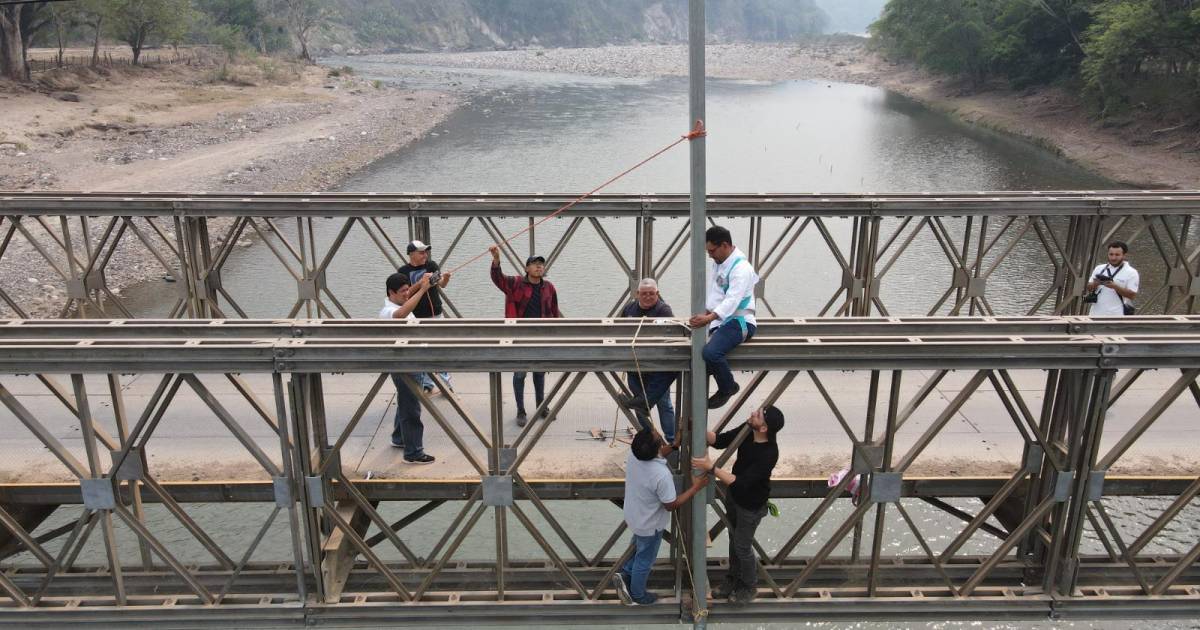Global Courant 2023-05-18 11:18:17
San Manuel, Cortes
When people talk about the Eta and Iota storms in this municipality, the first memory that comes to mind is that of Jerónimo Ruiz trying to save his cattle herd from the enormous flood of the Ulúawhich came without warning.
The veteran rancher, with his languid strength due to age, had just taken his cows out to graze when the flood swept them away.
That afternoon in November 2020, the river entered with such fury that it made a deafening noise when it broke the board that had been intact for 20 years.
3 keys about monitoring
> 1. A range of NGOs are linked in a network to provide effective response before, during and after natural disasters. They have been working together on resilience for 22 years. > 2. In 2022, with the first phase of the Let’s Get Ready project, CASM and Trocaire invested around 600,000 euros. Ladders were painted on bridges, alarms were installed in communities and others. > 3. By involving nine more municipalities this year in preventive work, CASM/Trocaire and the other institutions that partner with technicians will invest more than 600,000 euros. > 4. The riverside population has been trained to make decisions in case of emergency. They also know how monitoring instruments like rain gauges work. > 5. The devices installed to measure river flows are only useful for experts who monitor them and must be taken care of by the population, since they have been placed on bridges. > 6. After Hurricane Mitch, the USGS donated telemetry stations to monitor the rivers, of 60 that were installed now only two are working.
Within seconds, chaos broke out. Everyone ran from one side to the other wanting to save their things, their lives, their animals.
Ruiz was unable to rescue all of his cows, estimated to be more than 30; neither his forces nor those of the river allowed it. Those who did not die swept away by the flood ended up drowning on the way. From that discharge of water that descended at enormous speed from Jesús de Otoro and Santa Bárbara where the river is supplied Ulúathere was no anticipated early warning.
“ For every dollar invested in prevention, seven dollars are saved in response. “
Gustavo Reyes, risk management specialist
Although the river has two telemetric stations to read the level of the flow in Santiago, a village of Pimienta, upstream of San Manuel, and the other in Chinda, San Bárbara, before Eta and Iota They were hardly monitored, remember residents.
Three years after that horror that struck San Manuel and all the neighboring municipalities of Ulúa and its branches, it is less likely that a tragedy like the one that ended up aging Jerónimo, who still regrets having lost a young stud bull valued at more than 60,000 lempiras, will happen again.
satellite surveillance
As a result of the enormous floods that came down from the basin of the Ulúafirst with eta and a week later with Iota, and in the absence of a preventive alert to avoid loss of life and early evacuations, several institutions upriver have been working on modernizing and improving the times to alert the residents who live downstream.
To give you an idea of what they are doing, now the two powerful rivers that bathe the Sula Valley: the Ulúa and the Chamelecón They are being monitored from a satellite, which in real time, captures information on the level of the rivers and the speed at which the floods drop, when considerable storms occur in the basins. This will allow a precise alert with a margin of 19 hours only in Ulúa.
In other words, if you live in the Policarpo Paz García neighborhood of El Progreso, the first to flood when Ulúa rises, you can evacuate your house and take out your belongings 19 hours in advance before it floods everything. This will save lives and material goods.
so they will
In the middle and upper zone of the basins of the Ulúa and Chamelecón rivers Work has been going on since last year with the early warning project “Let’s get ready”, promoted by the Mennonite Social Action Commission (Casm) and Trocaire with funds from the European Union and the Catholic Church of Ireland.
They are accompanied by Center for Studies and Development of the Sula Valley (CEDVS), copeco and seven municipalities in the middle and upper basin of the Ulúa in Santa Barbara and two from the chamelecon from the same department.
To know
> Early warning systems do not prevent flooding, but they allow the population to be notified well in advance that a flood will subside. Early warning systems consist of three components: monitoring, alerts, and response. The first two occur upstream and the second in the Sula Valley. In the municipalities bordering both rivers in the Sula Valley, alarm systems will be installed to alert and issue evacuation orders.
Last year, with the first phase of early warning, the project gave a margin of 12 hours to warn of a flood in the flow, and now with the new devices installed in both rivers, by Ulúa the warning margin will rise to 19 hours and in the chameleconwhich had a three-hour warning margin from El Tablón, will be increased to eight or nine hours, explained Gustavo Reyes, risk management specialist at CASM and Trocaire.
To increase these times in favor of vulnerable families in San Pedro Sula, La Lima, Choloma, El Progreso, Santa Rita, San Manuel, Pimienta, Potrerillos and the Tigre de Tela branch, state-of-the-art, autonomous equipment has been installed. that is to say, with solar panels and chips to emit signals in both rivers. “We are calibrating them to have more expeditious information about the data they provide,” said Reyes.
Data monitoring will continue to be carried out by CEDVS, copeco and the municipal emergency committee (codem). Together they will improve their levels of coordination, their ability to respond through National Risk Management System.
“ The synergy between aid agencies and risk management systems has worked. “
Luis da Costa, head of Hydrology at CEDVS
With the project let’s get ready 21 municipalities are impacted and around 800,000 people globally, of which around 100,000 live on the banks of rivers.
The equipment that is being installed, unlike the telemetry stations donated in the past, is more autonomous, it even has its own solar panel and rechargeable batteries, its prices are more accessible, since each device is around 2,000 dollars with a life useful for up to seven years, and the software is updated every year by the suppliers.
The devices that are currently being calibrated are two lines of technology, one is a meteorological monitoring system and the other is a water depth sensor.
With the combination of both, precipitation, fluorometry, erosion, force and speed of water can be measured to make more assertive analyzes and notify alerts in impact zones with greater precision.
All the information is sent via satellite through mobile data to a database that is monitored on a computer, offering graphics in real time, which will not be affected by the ravages of the weather.
Comprehensive teams
Luis Da Costahead of hydrology at the CEDVS, explained that the higher up in the basin the measurement instruments are, the more alert time will be gained to alert the Sula Valley. He specified that the new equipment they have installed is comprehensive because in addition to measuring river flows and precipitation levels, they monitor radiation, temperature, humidity, and wind speed.
All of them will be complemented by the first phase of the project, which consisted of installing sirens in the riverside communities of San Bárbara, as well as rain gauges, where the population was also organized and trained, which in turn liaises with local emergency committees. and municipal.
He points out that they still have to work on the evacuation work because people always decide to leave their homes at the last minute so as not to leave behind their belongings, but he believes that with early warning, they will have a margin to save the material.
El Niño phenomenon causes drought, but increases hurricanes
San Pedro Sula. Honduras was declared on indefinite green alert on Monday, May 15, because the country will be influenced by the El Nino phenomenon.
This warning is valid for 64 municipalities in six departments of the country, due to possible meteorological drought, product of the El Niño phenomenonwhich would affect the national territory by 2023.
According to the updated climate outlook report of the Center for Atmospheric, Oceanographic and Seismic Studies (Cenaos), this year will be affected by the El Niño phenomenonwhich will leave little rain in the national territory and in different periods, accentuating the drought with greater force between June 10 and July 10.
In the bulletin issued on Monday, they state that El Niño began to manifest itself from May, leaving scarce and weak rains and it will be intensifying from June, due to the increase in temperatures in the Pacific Ocean, affecting the corridor more intensely. dry.
Regarding what causes The boy, Luis Da Costa from CEDVS, points out that although it produces drought, it also causes warming of the Caribbean Sea, which favors the formation of storms and hurricanes. The phenomenon is not yet very marked so we must wait for its evolution.








